
Martin Luther as an Augustine Monk
1. Forms of representation and historical context
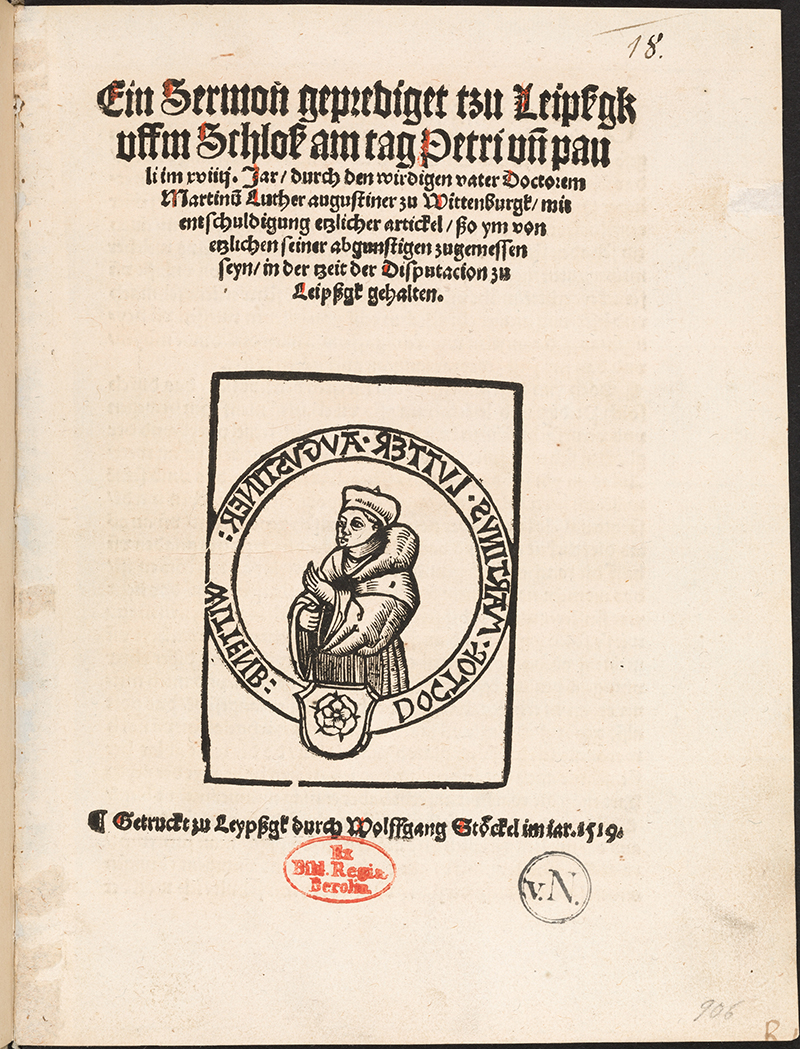
Abb. 1: Wolfgang Stöckel (Drucker), Titelblatt zu "Ein Sermon geprediget tzu Leipzgk…", Leipzig 1519, Holzschnitt mit Typendruck, Exemplar der Staatsbibliothek zu Berlin - Preußischer Kulturbesitz, KKL-Nr. I.1D1
Upon entering the Order of St Augustine in 1505 Luther was obliged to wear the Order’s habit, consisting of a black woollen garment with a hood and a leather belt. The habit therefore became the characteristic attribute of the earliest Luther portraits, which consistently depicted the future well-known reformer as a monk.[1] The representations of Luther as an Augustine monk can be divided into six subgroups according to criteria related to motif and genre (I.1 bis I.6).[2]
The subject of Martin Luther as ‘Augustinian Monk’ is primarily reserved for the realm of prints. From the period under study 36 printed portraits are known as opposed to just three surviving paintings, which cannot be accurately dated.[3] In view of the potential of engravings and woodcuts for reproduction the medium of print was therefore the most important for the dissemination of Luther’s portrait in the initial years of the Reformation.
The earliest known depiction of Luther is on the title page of a text published by Johannes Stöckel in Leipzig between the beginning of August and the 3 September 1519 on the occasion of the Leipzig Disputation between Johannes Eck and Luther or Andreas Bodenstein of Karlstadt (fig. 1). Since this is only a simple representation of a monk with a doctoral cap and a hand raised in a gesture of speech, that has no claim to being a true likeness, it forms as it were just the prologue for the Luther portraits (I.1.D1).
In addition to the engravings of the gaunt monk (I.1D2) Portrait Group I also includes the engraving of the ‘Monk in front of a Niche’ or wall opening (I.2D1), with a book (I.1D3, I.1D4, I.2D1 to I.3D3 and I.3D5 to I.3D9) or the Holy Spirit as a dove (I.2D7.2, I.2D7.4, I.3D1, I.2D2a to I.3D9), as well as special variants like the full-length figure of Luther seated at a writing desk (I.3D5). Furthermore, the subject of Luther as a scholar in profile with a cap (I.4D1 to I.4D5) also belongs to this group. A large number of depictions of Luther that were exclusively published in print show the monk in a habit as a full-length figure. However, the majority of these works cannot strictly be considered as Luther portraits because the figure of the monk is a very stylized and largely interchangeable type with no attempt to achieve a portrait-like resemblance. Only the earliest three examples of this type were entered in the KKL (I.5D1 to I.5D3) as representatives from which the remaining full-length depictions are directly or indirectly derived.[4]
[1] See Brecht 1981, pp. 65 and 70.
[2] I.1: print, bust portrait/half-length figure, I.2: print, half-length figure with niche/wall opening, I.3: print, bust portrait/half-length figure/full-length figure with the Holy Spirit as a dove, I.4: print, bust portrait with cap/doctoral cap, I.5: print, full-length figure, I.6: painting, bust portrait.
[3] See catalogue entries for I.6M1, I.6M2 and I.6M3.
[4] These include representations that were published from 1522/1523 in the following printed books VD 16 L 7206; VD 16 L 4824; VD 16 L 4825; VD 16 L 4821; VD 16 L 4822.
2. Historical Development/Evolution
In the primary sources the earliest record of a Martin Luther portrait refers to a painting. On the 12 November 1519 Duke Johann of Saxony wrote to Cranach’s employer, Elector Friedrich III, with the request: ‘Dear one would you also tell Master Lucas [Cranach] that I would like a painting of Doctor Marthinum.’[1] The portrait study that was surely done for such a painting could have formed the basis for the first engravings from the year 1520 (I.1D2, I.2D1). In January or February 1520 Albrecht Dürer communicated the desire for such an engraving via Georg Spalatin to the Elector.[2] The sources show firstly that Duke Johann of Saxony was already interested in a portrait of Luther by the beginning of 1520, secondly that an engraved portrait of Luther apparently did not exist at the beginning of 1520 and thirdly that painted portraits were evidently not yet in wide circulation.
[1] “E.[urer] L.[iebden] wollen auch beye meister Lucas [Cranach] anhalten das ich Doctor Marthinum mochte gemaldt uberkomen.“, Landesarchiv Thüringen – Hauptstaatsarchiv Weimar, Ernestinisches Gesamtarchiv, Reg. C 692, sheet 41r-42v. See Rossmann/Doebner 1908, p. 449; Exhib. Cat. Wittenberg 2013, no. 65.
[2] See the thank-you letter from Albrecht Dürer to Georg Spalatin for providing him with various Luther texts (cited after Rupprich 1956, Bd. 1, no. 32, p. 86, lines 10–23.) „Des halb pit jch, ewer er wird wollent seinen kürfurschlichen genaden mein vndertenige danckbarkeit noch dem höchsten antzeigen, vnd sein c[urfürschtliche] g[enaden] jn aller vndertenikeit pitten, das er jm den löblichen d[octor] M[artinum] L[uther] befohlen las sein, van kristlicher worheit wegen, doran vns mer leit dan an allenn reichtumen vnd gewalt diser weit; das dan als myt der czeit vergett, allein dy worheit beleibt ewig. Vnd hilft mir got, das jch zw doctor Martinus Luther kum, so will jch jn mit fleis kunterfetten vnd jn kupfer stechen zw einer langen gedechtnus des kristlichen mans, der mir aws grossen engsten gehollfen hat.“
‚Therefore, I would like to show your electoral grace my gratitude and to ask your electoral grace in all subservience, that he recommend him to the commendable doctor Martin Luther for the sake of Christian truth, which will guide us better than all the riches and violence of this world; that pass away with time, only the truth remains eternal. And if God helps me to come to Doctor Martin Luther then I will portray him and engrave him in copper as a lasting memorial of the Christian man who helped me out of great fear.’
3. Martin Luther as an Augustine Monk in Print
The engraved portraits of Martin Luther by Lucas Cranach the Elder from the years 1520 (I.1D2, I.2D1) (fig. 2 and 3) and 1521 (I.4D1) (Abb. 4) must therefore still be considered the earliest representations. Whereas Cranach’s first version of the gaunt monk (I.1D2) does not appear to have been widely disseminated in its first state (today only two specimens are known), but rather only from about 1568 and after considerable reworking of the block were the second and third states (I.1D2.2, I.1D2.3) printed in large numbers; particularly Cranach’s second version (I.2D1), which was published in the same year and shows Luther in front of a niche in a slightly larger format (I.2D1), received a wide reception. The huge publishing success of Luther’s texts soon created the need for a portrait of the author, that was met by publishing houses in Augsburg, Basel and Strasbourg by using images based on Cranach’s print. The engraved prototype was transferred to woodcut, because this permitted far more editions. From 1519 to 1530, the time frame for this study, a total of 83 texts were published with autonomous portraits of Martin Luther that drew on Cranach’s prototype and differed only marginally from each other (I.2D2, I.2D3.1, I.2D3.1). This type attained almost iconic significance: up until 1526 this portrait type was used exclusively and repeatedly for cover or author pictures of Luther, whereas Cranach’s depiction of Luther with a doctoral cap (I.4D1.1), available in its first state since 1521 was not deployed for book illustration. Its reception was reserved for the single sheet prints.
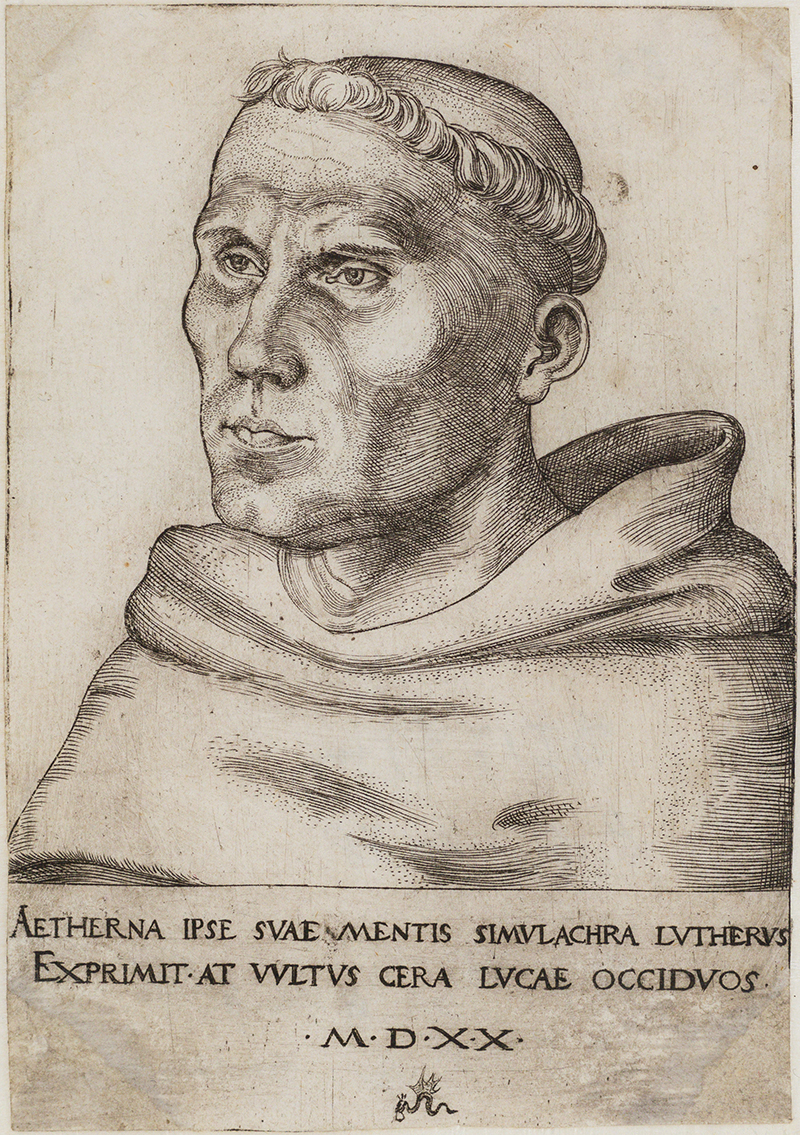
Abb. 2: Lucas Cranach d. Ä., Martin Luther als Augustinermönch im Ordenshabit, Halbfigur, nach links gewandt, mit Buch, vor einer halbrunden Nische, 1520, Kupferstich, Exemplar der Albertina Wien, KKL-Nr. I.1D2
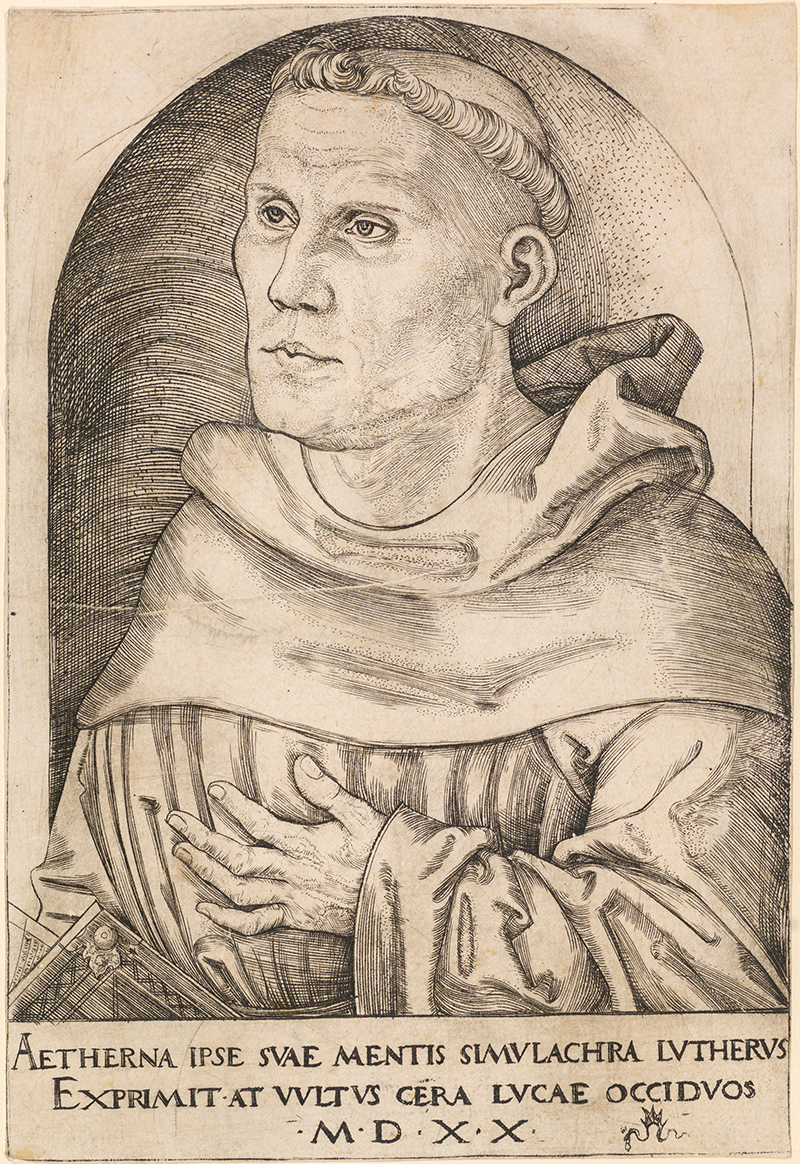
Abb. 3: Lucas Cranach d. Ä., Martin Luther als Augustinermönch im Ordenshabit, Halbfigur, nach links gewandt, mit Buch, vor einer halbrunden Nische, 1520, Kupferstich, Exemplar der Albertina Wien, KKL-NR. I.2D1
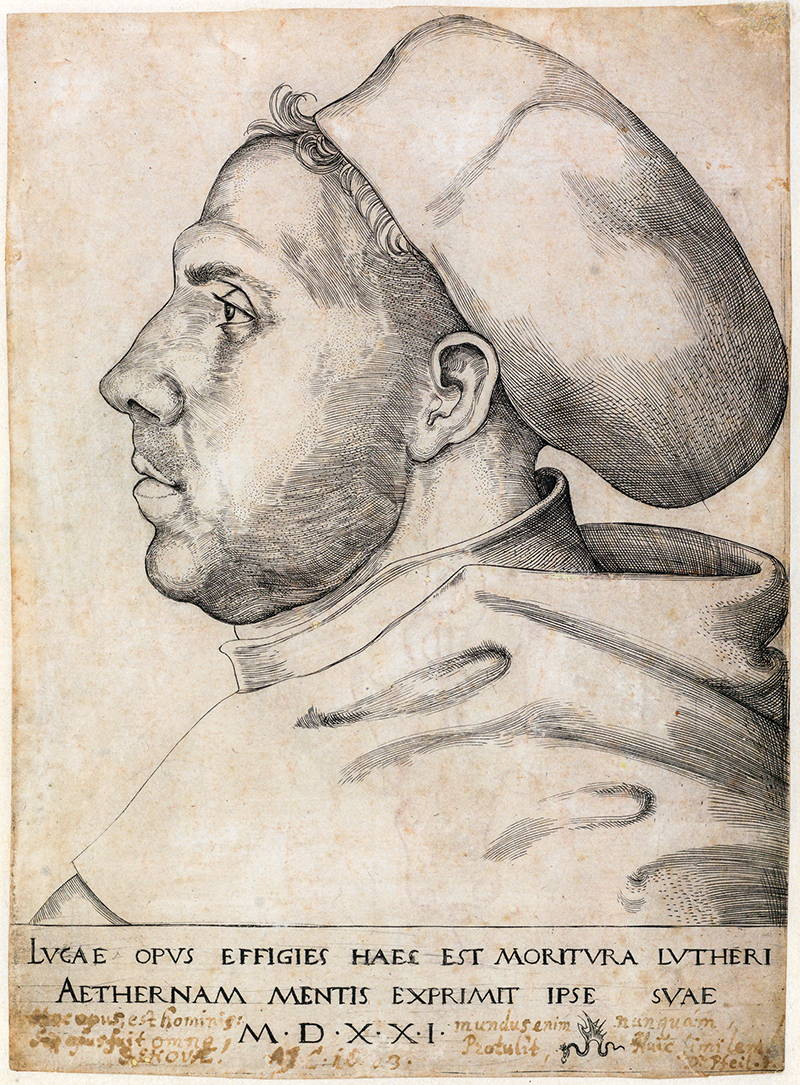
Abb. 4: Lucas Cranach d. Ä., Martin Luther als Augustinermönch im Ordenshabit, mit Doktorhut, Brustbild im Profil nach links, mit Inschrift, 1521, Kupferstich, Exemplar Kunstsammlungen der Veste Coburg, KKL-Nr. I.4D1
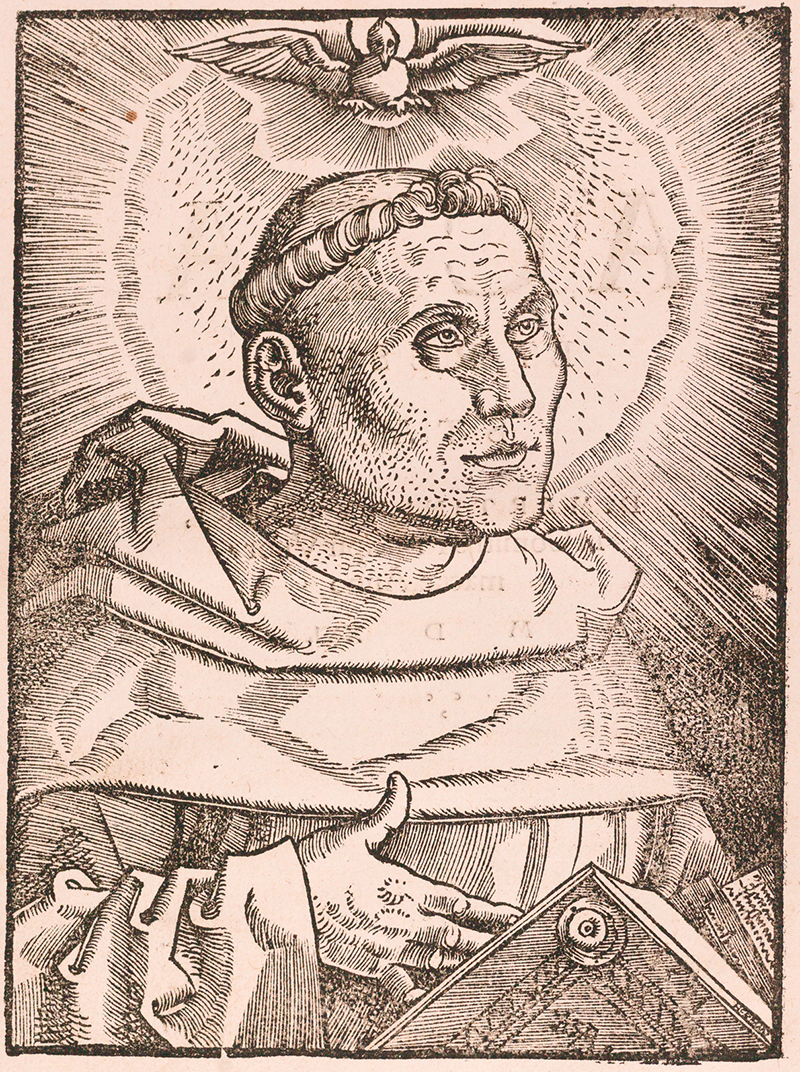
Abb. 5: Hans Baldung Grien, Martin Luther als Augustinermönch im Ordenshabit, Halbfigur nach rechts gewandt, im Strahlenkranz, mit Buch, Nimbus und Taube, zwischen 26. April und 8. Mai 1521, Holzschnitt, Exemplar der Herzog August Bibliothek Wolfenbüttel, KKL-Nr. I.3D1
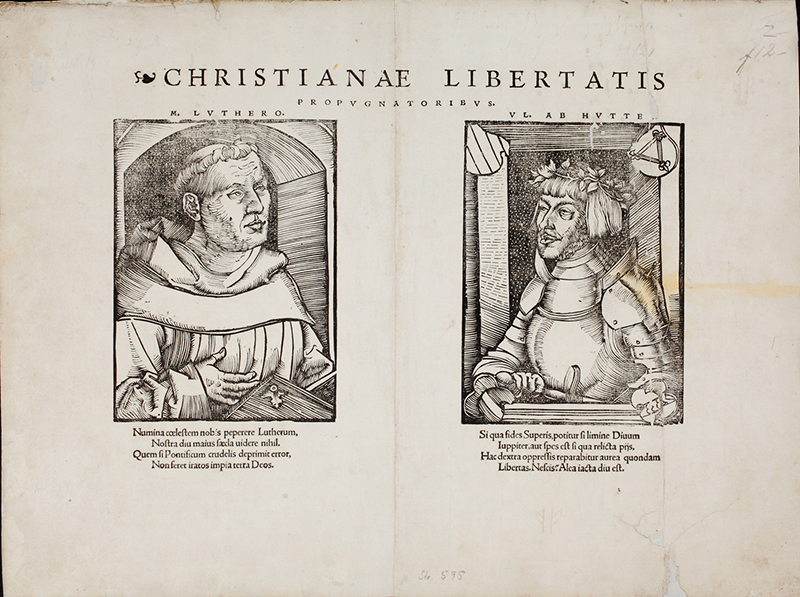
Abb. 6: Unbekannter Künstler, Flugblatt "Christianae Libertatis Propugnatoribus", nach Oktober 1520, Holzschnitt mit Typendruck, Exemplar der Staatsbibliothek zu Berlin - Preußischer Kulturbesitz, KKL-Nrn. I.2D4a und I.2D4b
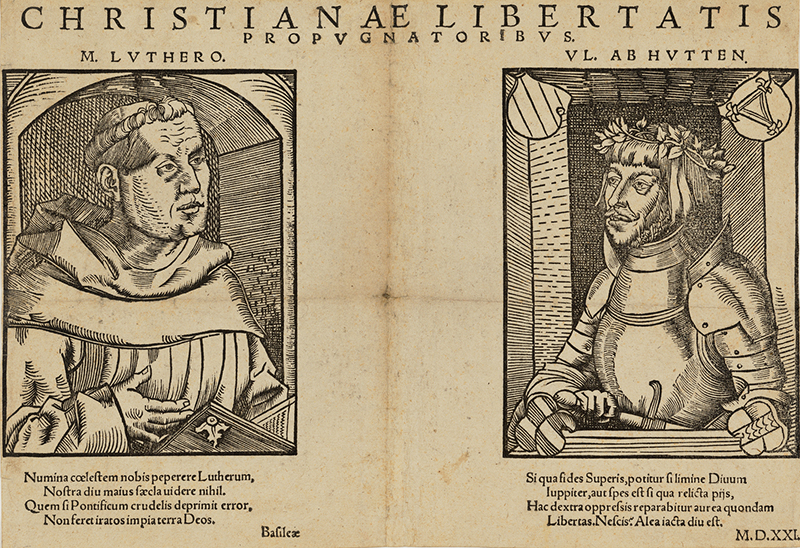
Abb. 7: Unbekannter Künstler, Flugblatt "Christianae Libertatis Propugnatoribus", nach Oktober 1520, Holzschnitt mit Typendruck, Exemplar der Klassik Stiftung Weimar, KKL-NR. I.2D3a und I.2D3b
On the 18 December 1520 the papal nuncio Hieronymus Aleander described different portraits, showing him (Luther) with the Holy Spirit as a dove and the crucifix, as well as with an aureole.[1] This cannot refer to the well-known depiction by Hans Baldung Griens (I.3D1), as the first verifiable printed version appeared between the 21 March and the 8 May 1521 (fig. 5).[2] Of the portraits that survive only Hieronymus Hopfer‘s iron engraving comes into consideration (I.3D6). This representation, that has aroused little attention due to its lack of artistic skill, is the only work known to us that could have been published by that time. It shows Luther with an aureole and a dove and the format would also have permitted the iconic function described by Hieronymus Aleander.[3] Further Luther portraits with and without haloes are also mentioned by Aleander, as well as the combination of a portrait of Luther with one of Ulrich of Hutten on a pamphlet with the title „CHRISTIANAE LIBERTATIS PROPVGNATORIBVS“.[4] Today the pamphlet exists in two versions (fig. 6 and 7) that can be traced back to different printing blocks. Both were examined and compared for the first time within the context of the KKL (I.2D3 and I.2D4). The portraits on these pamphlets are recuts of two portraits by Hans Baldung Grien whose adaptation of Lucas Cranach the Elder’s prototypes (I.2D2 and I.3D1, also I.4D2) contributed significantly to the dissemination of the Luther portrait. Even before the 13 January 1521 Hans Baldung Grien created the motif, showing a full-length figure of Luther as a monk (I.5D1). In his woodcut on the title page of Hutten’s „Gesprächbüchlein“ Grien combined this Luther portrait with a full-length figure of Ulrich of Hutten as an imperial knight.
Another pamphlet, surviving in a single example (I.3D2), also draws on Hans Baldung Grien’s work and suggests that there may have been an original version of the „CHRISTIANAE LIBERTATIS PROPVGNATORIBVS“ pamphlet furnished with Baldung’s Luther and Hutten portraits, but that only the two recut examples have survived.
The printed portraits from Portrait Group I can frequently be traced back to extremely similar, but not identical printing blocks.[5] Such close similarities would not be possible without an efficient means of transferring the same prototype directly to a new block. The first widespread Luther portraits were almost exclusively printed representations, that quickly broke away from the first prototypes found in Cranach’s engravings and soon developed their own characteristics. A closely interconnected network of humanists, artists, engravers, blockcutters, printmakers and publishers made this possible by circulating new pictorial ideas within a very short time. However, in the following years printed media conceded its leading position to the painted portraits, which from 1525, particularly due to the Cranach workshop, were put on the market in consistent quality, and moreover in large quantities and thus increasingly dominated the Luther portrait type.
[1] Depictions with such a combination of motifs are first found in Hans Sebald Beham’s illustrations for Hans Hergot’s edition of the September Testament from 1524 (I.3D5).
[2] Contrary to the recurring assumption in Kalkoff, 1897, p. 59.
[3] See ibid., pp. 58-59: „[…] und das kaufen sie, küssen es, und tragen es selbst in den Palast.“ ‘[…] and they buy it, kiss it, and even carry it into the palace.’
[4] See ibid., pp. 79–80.
[5] See for example the relationship of I.2D2 to I.2D3a, I.2D4a and I.2D5, of I.2D6 to I.2D7 or of I.3D1 to I.3D2a.
4. Martin Luther as an Augustinian Monk in Painting
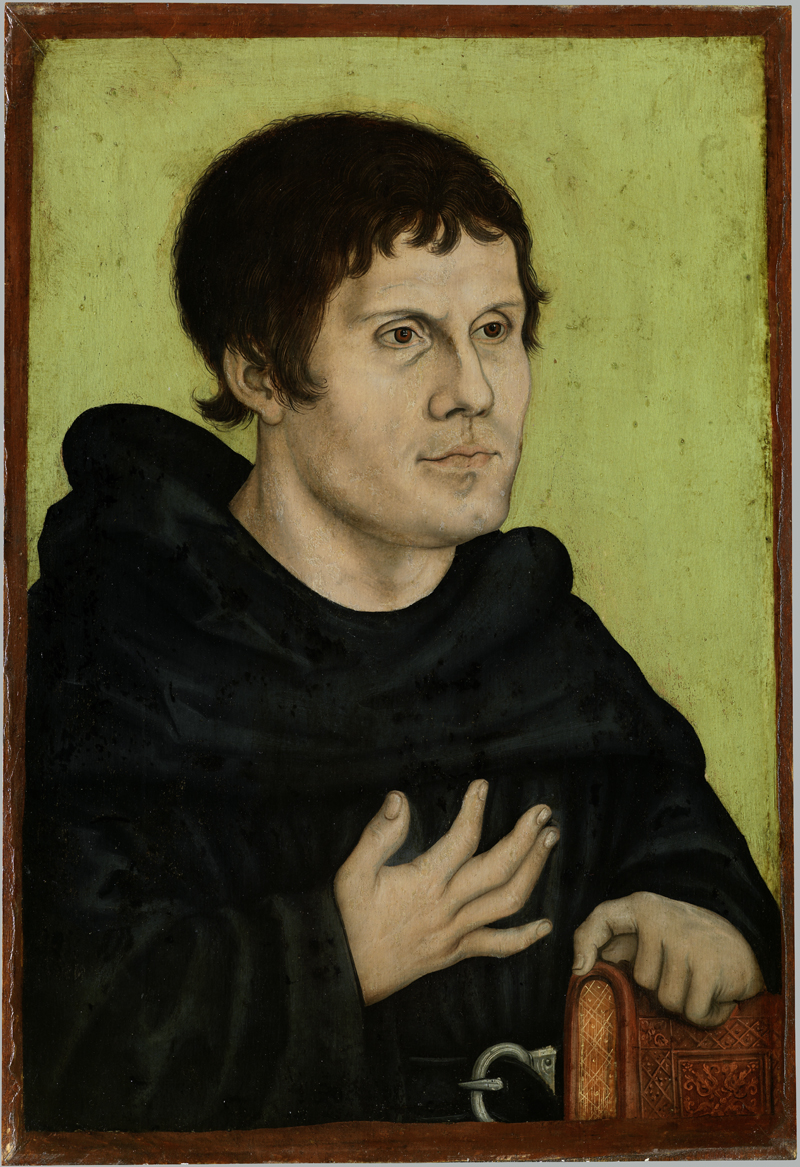
Abb. 8: Werkstatt Lucas Cranach d. Ä. oder Umkreis, Martin Luther als Augustinermönch, ab 1522, Malerei auf Pergament auf Buchenholz, Germanisches Nationalmuseum Nürnberg, Leihgabe der Paul Wolfgang Merkel‘schen Familienstiftung, KKL-Nr. I.6M1
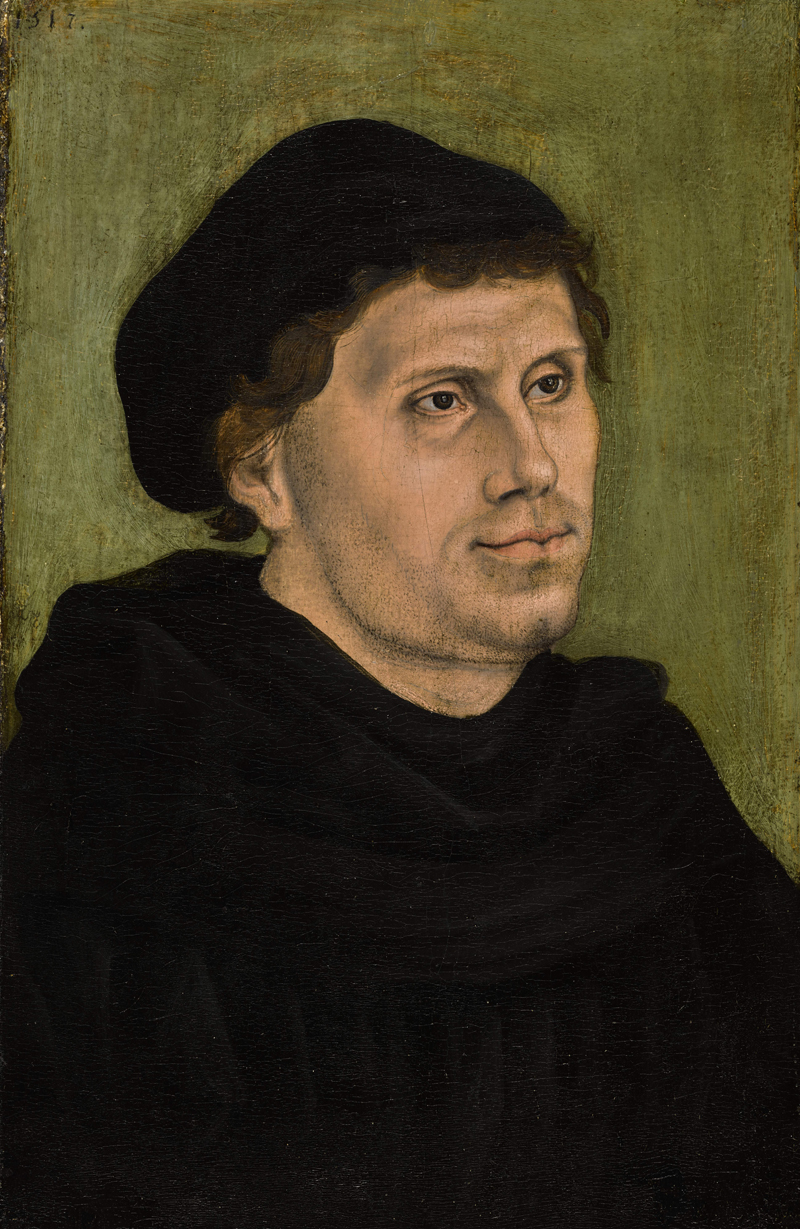
Abb. 9: Werkstatt Lucas Cranach d. Ä. oder Umkreis, Martin Luther als Augustinermönch, ab 1522, Malerei auf Lindenholz, Privatsammlung, KKL-Nr. I.6M2
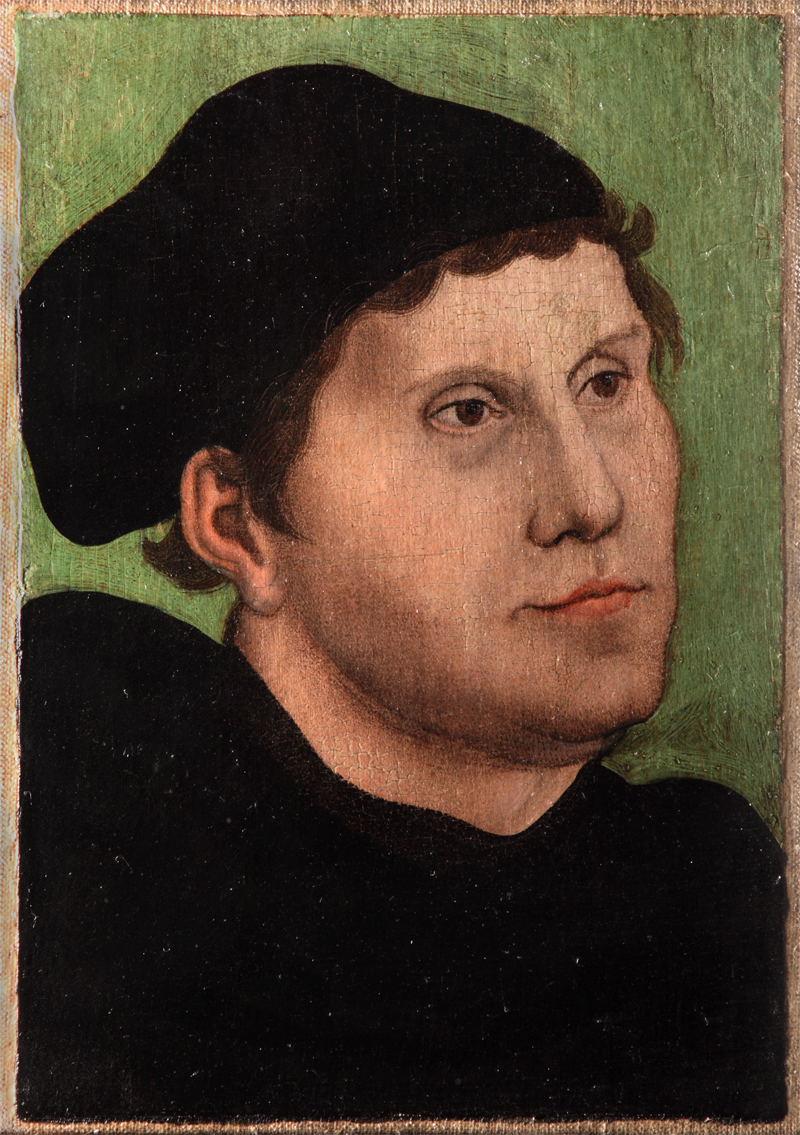
Abb. 10: Werkstatt Lucas Cranach d. Ä. oder Umkreis, Martin Luther als Augustinermönch, ab 1522, Malerei auf Holz, auf Leinwand übertragen, Stiftung Luthergedenkstätten in Sachsen-Anhalt, KKL-Nr. I.6M3
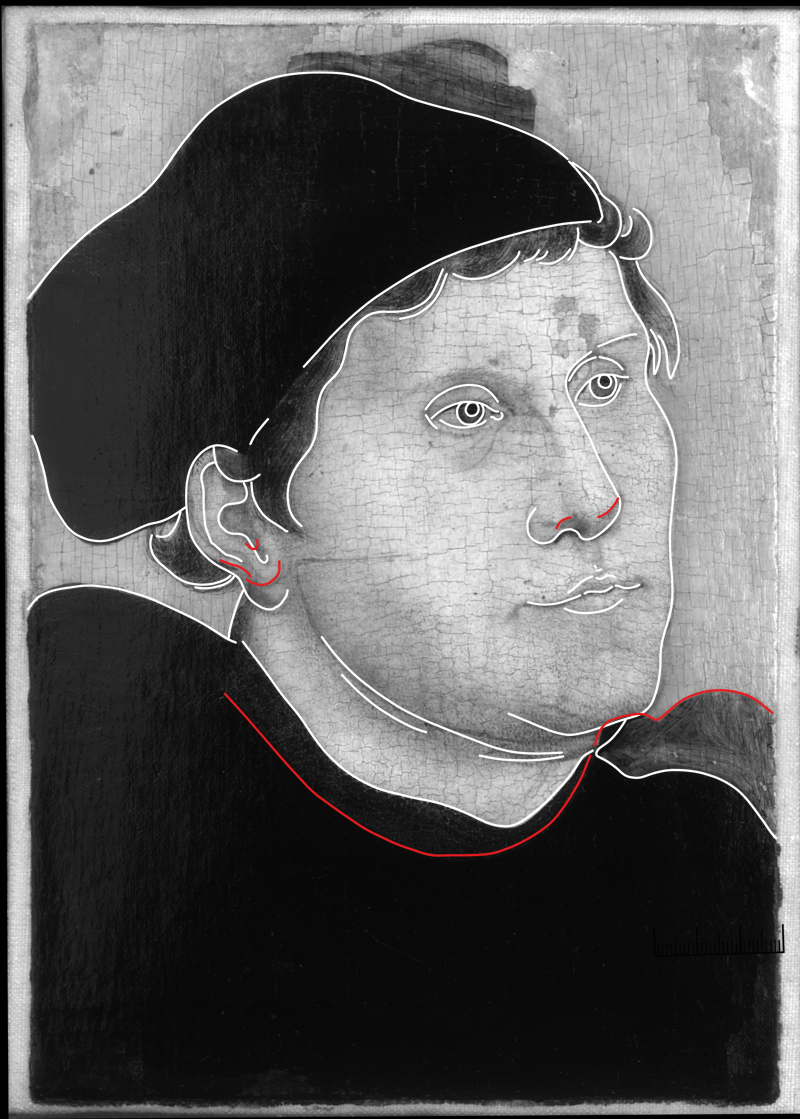
Abb. 11: Infrarotreflektogramm des Wittenberger Gemäldes (I.6M3) mit farbig markierten Konturlinien. In Weiß die ausgeführte Malerei, in Rot die ursprüngliche, korrigierte Formanlage
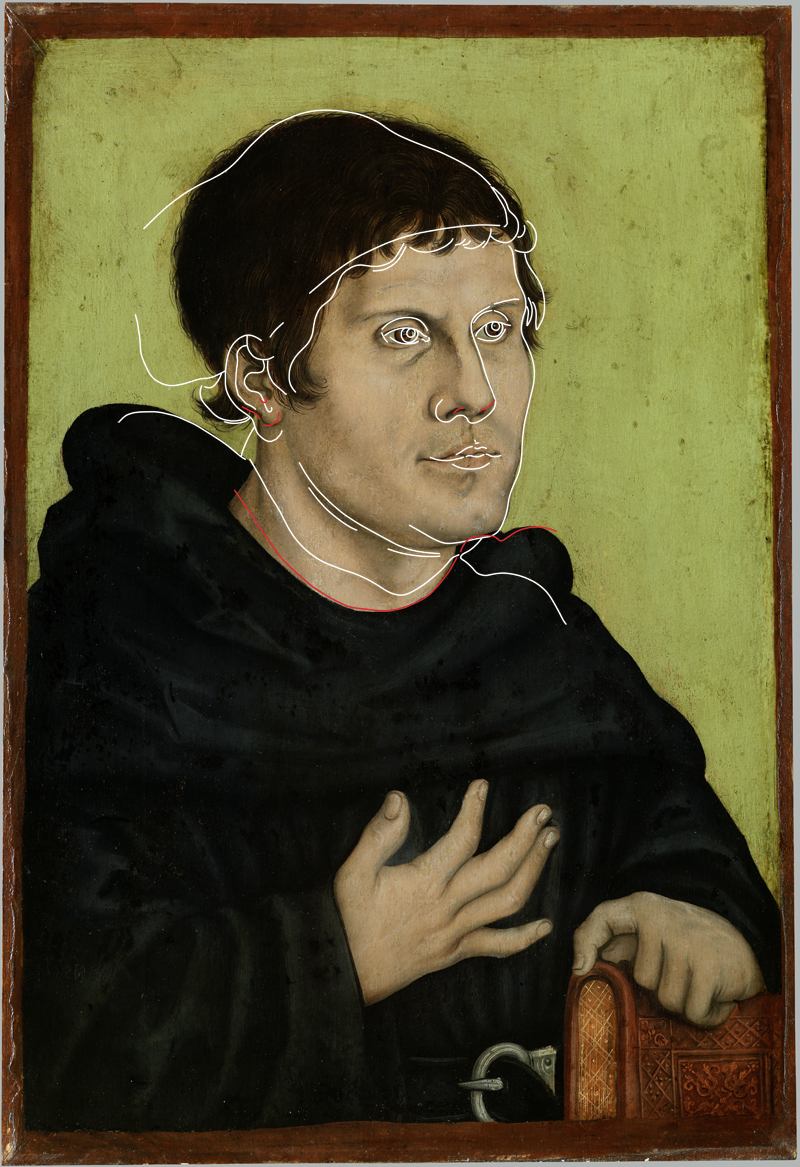
Abb. 12: Überblendung des Nürnberger Gemäldes (I.6M1) mit den Konturlinien des Wittenberger Gemäldes (I.6M3) in Weiß und Rot

Abb. 13: Überblendung des Gemäldes I.6M2 mit den Konturlinien des Wittenberger Gemäldes (I.6M3) in Weiß und Rot
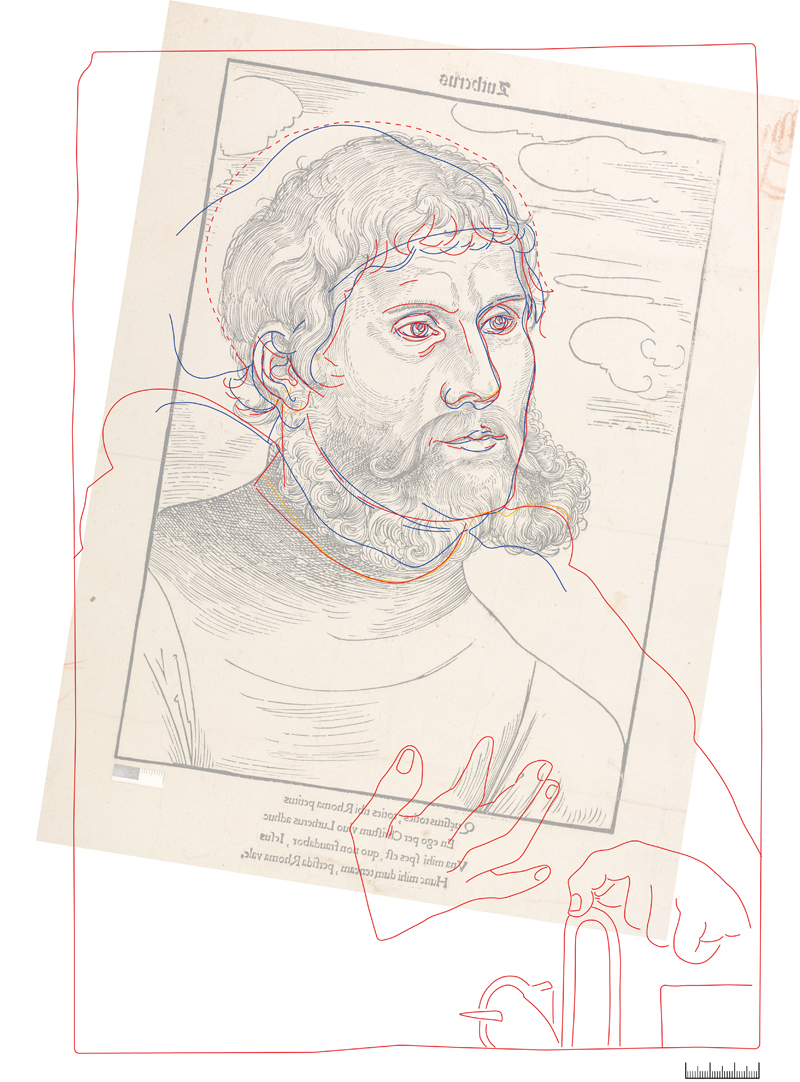
Abb. 14: Überblendung dem Dresdner Exemplar des Holzschnitts "Junker Jörg" (II.D1) mit der Umzeichnung des Nürnberger Gemäldes (I.6M1) in Rot und den Konturlinien des Wittenberger Gemäldes (I.6M3) in Blau (ausgeführte Malerei) und Orange (Formanlage)
Three paintings, showing Luther in a monk’s habit, were in previous research dated to the early 1520s (I.6M1 to I.6M3). These include the portrait in Nuremberg of Luther as an Augustinian monk with a book (I.6M1), which shows Luther in a monk’s habit without a tonsure and was at the latest by 1983 generally considered to be a particularly authentic portrait (fig. 8).[1]
Following an interim re-evaluation and dating of the portrait to ‘after 1546‘, because it appeared to be compiled of different prototypes from the Cranach workshop, the most recent examinations suggest that an earlier production date in the Cranach workshop is again plausible.[2] The other two versions also show Luther in a habit, but with a doctoral cap, beneath which curls of hair are visible at the nape of the neck (fig. 9). Up to now both have generally been dated to about 1520/21 by scholars.[3] Whereas the one in a private collection (I.6M2) is painted on lime wood[4], the version in Wittenberg (I.6M3), also originally painted on wood, has been cropped and transferred to a canvas support (fig. 10). Changes made during the painting process are particularly apparent in the latter and can be interpreted as individual characteristics (fig. 11).[5] It seems possible that both versions may have originated in the Cranach workshop or in its close circle.[6] The individual characteristics of the underdrawings on all three paintings, executed in each case with a blackish fluid medium and brush, distinguish them above all from the Luther portraits produced in great numbers in the Cranach workshop after 1525 in which the underdrawing consists of a few very fine lines. Especially in I.6M1 and I.6M2 the striking brush-underdrawings differentiate them not only from each other but also from works unanimously attributed by scholars to Lucas Cranach the Elder.[7] At the same time the facial contours of the three Luther portraits correspond to a large extent in total size (fig. 12 and 13).[8] This suggests that all three versions may have relied on a common prototype. First and foremost the ‚Junker Jörg‘ woodcut by Cranach dated 1522 (II.D1) can be suggested in this connection because the facial features correspond with all three portraits both in size and proportion (fig. 14).[9]
[1] See Exhib. Cat. Nuremberg 1983, no. 363; Löcher 1997, p. 136.
[2] For the dating of the work to ‚after 1546‘, see Hess/Mack 2010, pp 279–295; for the most recent research see also the catalogue entry for I.M61.
[3] For dating see catalogue entries I.6M1 to I.6M3.
[4] In the period from about 1520 to 1535 beech wood was used more frequently for small and medium format panel paintings in the Cranach workshop. All the surviving Luther portraits from this period are painted on beech panels. See also Heydenreich 2007, pp. 47-51. A cross-evaluation of the results from the Luther portraits will be presented in a technical studies paper (in preparation).
[5] See the catalogue entry for I.6M3.
[6] The present condition of the example in Wittenberg (I.6M3) does not permit any clear conclusions be drawn, see the catalogue entry for I.6M3. In contrast the type of wood chosen for I.6M2 and how the support was treated, as well as the characteristics of the underdrawing do not correspond with those of portraits produced in the Cranach workshop about 1520 – 1530. Based on this evidence a later production date by a follower of Cranach would seem more plausible. However, as the painting could not be examined during the research project no final conclusions can be made.
[7] Only the version in Nuremberg exhibits characteristics that are similar to underdrawings of portraits attributed to the so-called Master of the Mass of St Gregory, see the catalogue entry for I.6M1. The infrared reflectogram of the Wittenberg version shows a very economical and only faintly visible underdrawing that indicates just the main forms with a few lines. The considerably more detailed underdrawing of the portrait in a private collection is clearly visible in the infrared reflectogram and differs from all other Luther portraits by employing hatching strokes to create volume and in that respect also exhibits similarities with underdrawings by the so-called Master of the Mass of St Gregory. See for example [DE_BStGS_6271](https://lucascranach.org/DE_BStGS_6271) and [DE_BStGS_6270](https://lucascranach.org/DE_BStGS_6270).
[8] There are fewer differences between I.6M2 and I.6M3 than there are with I.6M1. In particular the position of the ear and the nose differs considerably from the other two versions. However, as revealed by the infrared reflectogram this area was altered in I.6M3 during the painting process and the original shape corresponds more closely to I.6M1. See the catalogue entry for I.6M1 and I.6M3.
[9] The relationship of the woodcut to the Nuremberg portrait (I.6M1) has already been discussed in great depth by Hess/Mack 2010.